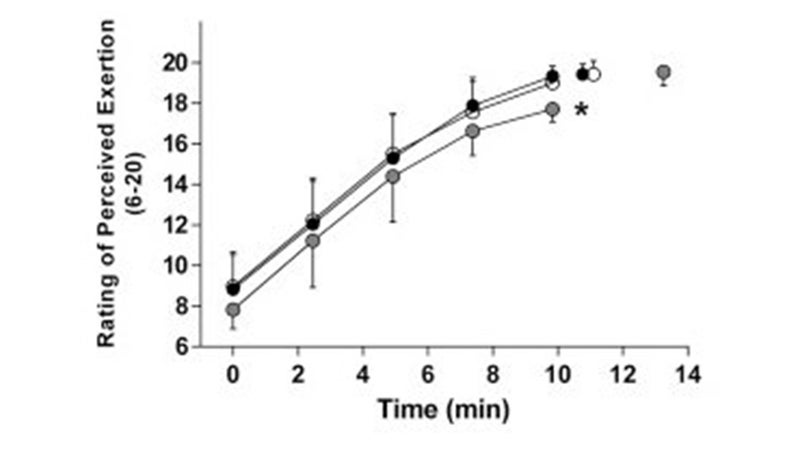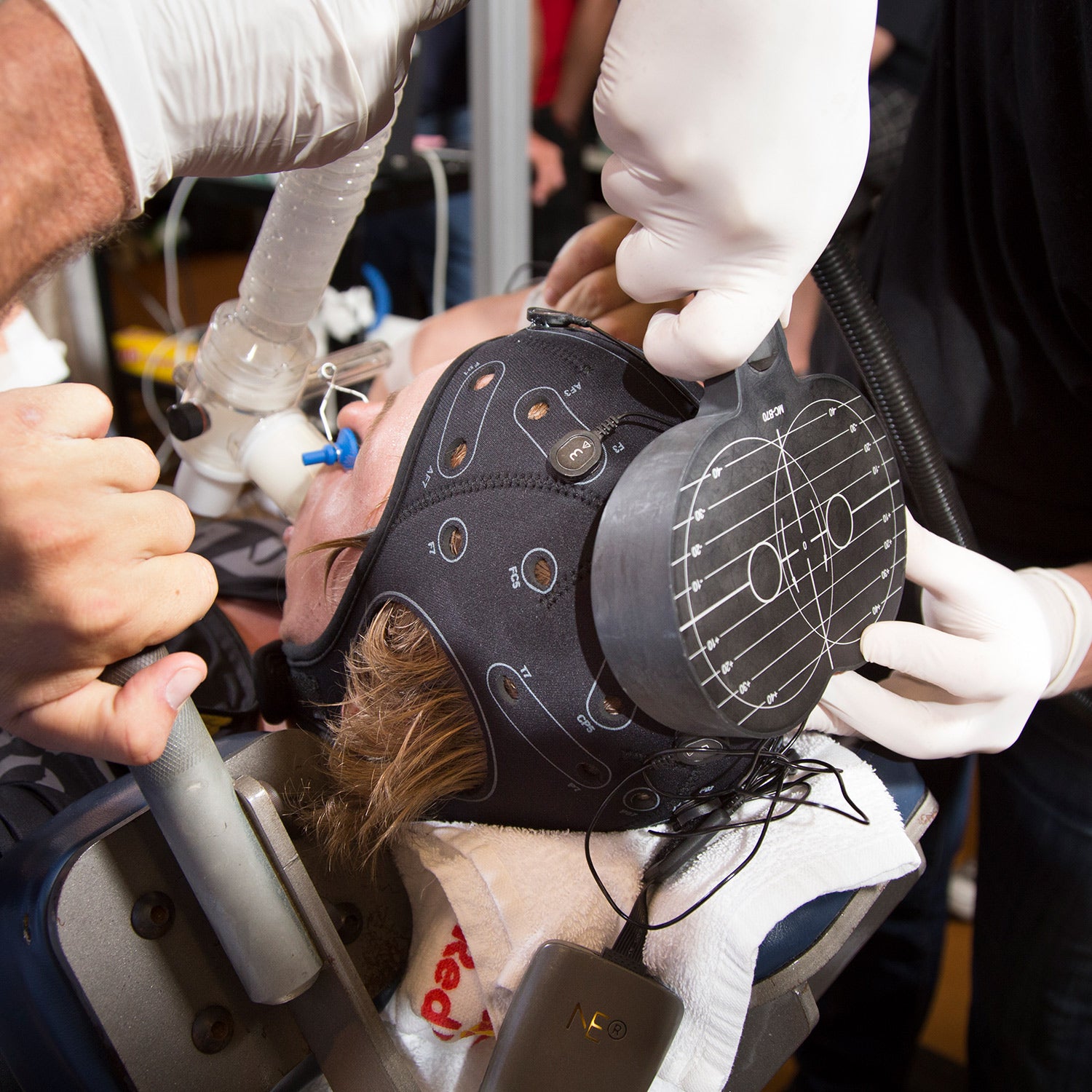Back in 2013, a small that felt like a very big deal. For years┬áresearchers had been debating whether the brain, for its own protection, keeps a hidden reserve of energy even when youÔÇÖre pushed to what feels like your ultimate physical limits. Brazilian researchers used a then obscure technique called transcranial direct current stimulation, or tDCS, to apply electricity to the brains of ten┬ánational-class cyclists before a series of incremental rides to exhaustionÔÇöand the brain stimulation enabled them to increase their peak power by 4 percent.
Scientific implications aside, it was clear that athletes would be interested in this. In 2014, Red Bull started experimenting with tDCS on its cyclists and triathletes; two years later, players on the Golden State Warriors were trying from a Silicon Valley startup called Halo Neuroscience. The hype around tDCSÔÇönot just for sports┬ábut for everything from accelerated learning to stroke rehab to sniping skillsÔÇöwas building into a massive, all-consuming wave.
Meanwhile, the actual evidence was seemingly getting weaker. Earlier this year, University of Kent sports science researcher Alexis Mauger and his colleagues published of studies on tDCS and exercise performance. Of the 12 studies on endurance that they found, eight showed positive results. The success rate in studies of actual exercise like cycling (as opposed to contrived tests, like isometric elbow-flexor endurance) was even lower. More generally, tDCS hype has been facing a significant backlash, with one researcher the field as ÔÇťa sea of bullshit and bad science.ÔÇŁ
So, with all that in mind, IÔÇÖm not sure whether itÔÇÖs good or bad news that a new study from Mauger and his colleagues, published┬á, may bring some much needed clarity to the fieldÔÇöand bolster the case that brain stimulation is a legitimately powerful endurance booster. The gist of the study is straightforward: 12 volunteers received real or faux┬ábrain stimulation (with the electrodes on your head, itÔÇÖs impossible to tell whether the current is on or off), then did cycling tests to exhaustion that lasted about ten┬áminutes. With brain stimulation, participants┬álasted 23.5 percent longer on the bikeÔÇö12.61 minutes instead of 10.21.
There are a couple of key methodological advances that support the idea that this isnÔÇÖt just another lucky coin toss. The first is in the placement of the electrodes. The tDCS technique involves attaching wires to a current source (like a nine-volt battery) and connecting them to your head. As current passes through your brain, it changes the excitability of the neurons (which are basically connected to each other like a network of miniature electrical circuits), making certain neurons more or less likely to fire depending on the direction of the current and the placement of the electrodes.
That means tDCS makes neurons more excitable under one electrode and less excitable under the other electrode. So itÔÇÖs possible that whatever positive effects you might get from increased excitability might be wiped out by negative effects from the other electrode. The solution: put the second electrode on the shoulder instead of the scalp, so that the current runs through the brain in one direction only. ThatÔÇÖs the approach Mauger took in last year.
The second change is to recognize that it takes two legs to cycle. While this may seem obvious, it┬áalso means that there are two areas of the brain responsible for sending signals to the legsÔÇöso one pair of electrodes isnÔÇÖt enough. In the new study, the subjects had two pairs of electrodes, with the negative electrodes over the right and left sides of the motor cortex and the positive electrodes on the respective shoulders.
(As a side note, they also tried it with the electrodes reversed, so the positive electrodes were on the scalp, and it didnÔÇÖt help performance. Contrary to expectations, it┬ádidnÔÇÖt hurt performance either, for reasons that arenÔÇÖt clear.)
From a scientific perspective, there are some interesting implications here. The paper explains these results in the context of the ÔÇťpsychobiological theoryÔÇŁ proposed by one of MaugerÔÇÖs coauthors, Samuele Marcora, which argues that the determining factor in endurance performance is your sense of perceived effort. When exercise feels too hard, you slow down or stop, which means that anything that alters your sense of effortÔÇölike electrons to the brainÔÇöcan alter your physical endurance.
Sure enough, in this study, the rating of perceived exertion (RPE) reported by the subjects was lower right from the start of the cycling test, before they were even tired. Check out the graph here, with black dots showing the control, grey dots showing the tDCS, and white dots showing the reversed tDCS. (The RPE scale runs from 6 to 20, a somewhat odd choice that was originally chosen in the 1960s to be roughly proportional to heart rate divided by ten.)

If you check out the full set of graphs (figure 2 in the paper, which is online), youÔÇÖll see that ratings of pain, as well as heart rate, are totally identical throughout the rides, for all three conditions. Physiologically,┬áeverything is the sameÔÇöit just feels easier after tDCS, so study participants┬ácan continue longer before hitting maximum effort.
ThatÔÇÖs a pretty compelling picture. But what is ÔÇťsense of effort,ÔÇŁ anyway? In the science community, itÔÇÖs┬áanother bone of contention. Intuitively┬áwe tend to think of effort as a reflection of all the disturbances in the body: the more your heart pounds, the more dehydrated you get, the more lactate builds up in your muscles, and the hotter you getÔÇöall these factors are sensed by the brain┬áand translated into the feeling that your ride is getting harder.
Marcora argues instead that effort isnÔÇÖt a consequence of incoming signals from the body. Rather itÔÇÖs a reflection of outgoing signals from the brain. As your muscles get tired, your brain has to send stronger and stronger signals to elicit the same power from them. Essentially, one part of your brain detects the electrical activity in other parts of the brain generating the signals to your muscles, and this dictates your sense of effort.
In MarcoraÔÇÖs view, then, hereÔÇÖs whatÔÇÖs happening in the tDCS study:
- Electric current is applied to the motor cortex, which is the part of the brain that sends signals to the muscles telling them to contract.
- This electric current changes the excitability of the neurons, basically making them a little easier to trigger.
- To cycle at a given power output, the signal from the motor cortex to the muscles must be the same with or without tDCS. But with tDCS, the input to the motor cortex from other parts of the brain can be smaller and still produce the same output, since the neurons are easier to trigger.
- Your sense of effort is proportional to the strength of the signals going into the motor cortex. Since these input signals are smaller with tDCS, cycling at a given power feels easier.
- Since your decision to quit in a time-to-exhaustion test is determined by the feeling that your effort is maxed out, the lower sense of effort produced by tDCS allows you to cycle for longer.
ItÔÇÖs worth noting that the experiment included tests of neuromuscular function, including one test that involved directly triggering the motor cortex with a magnetic stimulator to produce a twitch in the quadriceps. Sure enough, ÔÇťcorticospinal excitabilityÔÇŁ was increased by tDCS, meaning that the same input signal to the motor cortex produced a bigger output in the muscleÔÇöexactly as the theory predicts.
Interestingly, Mauger remains skeptical about the ÔÇťpsychobiologicalÔÇŁ explanation of tDCSÔÇÖs effectiveness, even though heÔÇÖs the corresponding author of the paper. ItÔÇÖs clear that brain stimulation altered perception of effort, he acknowledges. But whether thatÔÇÖs the underlying cause of tDCSÔÇÖs performance boost, or just a byproduct of some deeper mechanism, will require further studies to sort out.
For now, thereÔÇÖs one thing that Marcora and Mauger definitely agree on, which is that the performance-boosting effects of brain stimulation are real enough that the sports world needs to grapple with the topic. Marcora notes that, for practical purposes, the effects of ten┬áminutes of tDCS last for about an hour, so itÔÇÖs main relevance would be in events lasting an hour or less.
For Mauger, the results are as worrying as they are scientifically interesting. ÔÇťMy concern with the study is we have shown that brain stimulation can improve performance in a meaningful way,ÔÇŁ he told me. ÔÇťI think this has implications for the ethical use of such methods in sport, and I still have concerns about the safety of these devices, particularly when used regularly for a long period. I would like to see anti-doping and sporting bodies take some initiative on this, and consider whether they think tDCS is something that should be regulated in their sport.ÔÇŁ
I agree with Mauger on this. Endurance athletes like Tour de France cyclist-turned-triathlete┬á and Ironman triathlete are among the athletes already experimenting with brain stimulation. The methodological adjustments described by Mauger in the new study make me suspect that what theyÔÇÖve been doing so far is probably uselessÔÇöafter all, no commercial products that IÔÇÖm aware of use shoulder-mounted electrodes. But it wonÔÇÖt be long before athletes start getting it right. So if you thought shoes with carbon-fiber plates in them violated the spirit of the sport, just wait until you see high school athletes wiring up their brains before meets.
Discuss this post on or , sign up for the Sweat Science , and check out my forthcoming book, .


